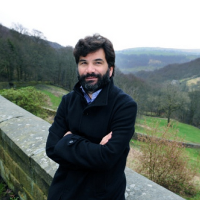Does Your Rabbi Know You’re Here? The Story of English Football’s Forgotten Tribe
Anthony Clavane
Quercus, 269pp, £17.99
“Football is not for a Yiddisher boy,” Anthony Clavane is told at school and so has a football confiscated, followed in turn by a tennis ball, an apple core and an orange peel. This Pythonesque anecdote suggests English Jews were hostile to “footbollick”; that they considered the sport unfitting for the people of the book.
Clavane offers us a splendid, warmly written slice of untold social history to prove otherwise. His tales of Jewish players, fans, managers and directors illuminate a much broader canvas: the story of how Jews “became English” and how far becoming English and “staying Jewish” were in tension. For many decades, Anglo-Jewry had a conscious preference for assimilation. It was possible to belong but not to rock the boat; the fear of stoking anti- Semitism was rarely far away.
 Spurs was the club most associated with Jewish support, even though West Ham was closer to large Jewish communities around Spitalfields and Whitechapel. Tram routes had a lot to do with it. Combustion-engine-powered cars and buses were forbidden on the Sabbath but the electric tram, stopping outside White Hart Lane, was not. One in three of 30,000 fans at a Tottenham home game in the 1930s was Jewish.
Spurs was the club most associated with Jewish support, even though West Ham was closer to large Jewish communities around Spitalfields and Whitechapel. Tram routes had a lot to do with it. Combustion-engine-powered cars and buses were forbidden on the Sabbath but the electric tram, stopping outside White Hart Lane, was not. One in three of 30,000 fans at a Tottenham home game in the 1930s was Jewish.
Choosing that ground for the England v Germany match in 1935 might be the oddest decision the Football Association has ever made. As a result of their naive insistence that the game was beyond politics, the English were outplayed by German football diplomacy. It was thought merely polite for the England team to give Nazi salutes and, as shown in a lesser-known image reproduced here, for the Nazi swastika to flutter above White Hart Lane. A brave Spurs fan climbed on to the roof and tore it down but was fined for his trouble. The Jewish Chronicle, having editorialised against protests over the game as “disorderly”, ignored that story, instead praising Jewish refugees from the Nazis for acting as interpreters and tour guides for the German visitors.
Spurs did not want to be known as a Jewish club, refusing to print a Jewish New Year’s message for decades. It was only when Mark Lazarus gave the third-division Queens Park Rangers a giant-killing League Cup triumph at Wembley in 1967 that Clavane and his north Leeds classmates realised that Jewish footballers existed. He finds many more good tales for this book but even an all-time best XI of Jewish players in English football might struggle to stay up. (England’s 1966 hero George Cohen, after some laudatory press coverage in the New York Times, had to point out politely that he wasn’t Jewish.) Lazarus’s striking partner would probably be Ronny Rosenthal of Liverpool and Israel, best known not for helping Liverpool win their last league title in 1990 but rather “that miss”, when he somehow hit the bar in front of an open goal at Villa Park. He tells the author he has no regrets: “It put me on the map.”
The real action takes place off the pitch. David Pleat, whose father anglicised the family name from Plotz, speaks here for the first time about being Jewish and why he avoided making it part of his public identity. Clavane plausibly suggests that Pleat had an outsider’s perspective, both tactically and in being an early adopter of black talent at Luton Town.
Clavane worries about reinforcing stereotypes but shows how the most transformative Jewish contributions to English football were in the boardroom. The Burnley chairman Bob Lord banned television cameras, declaring in 1974 that he would “stand up against a move to get soccer on the cheap by the Jews who run television”, but such stark anti-Semitism soon gave way to professionalism.
Irving Scholar’s Tottenham and David Dein’s Arsenal introduced basic commercial principles to the game. The fan Pini Zahavi became the first super-agent. Roman Abramovich gave us the era of the oligarch but is here benignly treated as an insurgent outsider by the left leaning, football-traditionalist author. Clavane catches himself, on the night Chelsea play the Champions League Final, wondering, somewhat anachronistically, what his grandparents and parents would always ask: which result “would be good for the Jews”?
As English football became globally popular, Jews found themselves no longer an outsider tribe; black players, meanwhile, had necessarily needed a different strategy to tackle prejudice. Decades before, football had been a vital site of integration. Teenage boys would go along to watch Leeds, Man City, Orient and the Arsenal and, by falling in love their teams, inherit another identity. The resulting Sabbathday tensions between stadium and synagogue provided a practical example of tensions between the generations (often involving sneaking out of the house), as the children of immigrants found their own balance between integration and assimilation, Jewish pride and fear of being the other.
British Jews are often cited as a model minority. What Clavane captures in this book is why it was such a long journey for them to find the confidence to voice the whole of their story.
Sunder Katwala
This article was originally published by the New Statesman.






